A few years ago, we spent 4th of July in America’s Hometown, Plymouth. What a difference a few hundred years make!

This is Plimoth Plantation’s Pilgrim settlement.
I chaperoned the 3rd grade field trip to Plimoth Planation and my group wanted to see the English settlement at Plimoth Plantation as their first stop and then onto the Native American settlement.

My group explores Plimoth Plantation’s English settlement.
Many of the houses had actors in character as actual people who lived here. We had a sheet of things to find and questions to ask so the kids ran through the settlement houses in search of settlers to talk to.
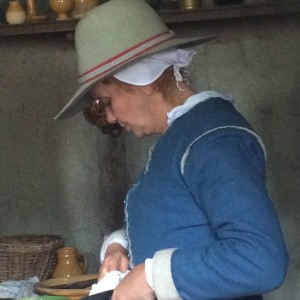
I found the interiors fascinating. It’s like an Open House tour during the 17th century. The houses varied quite a lot on the inside to reflect the inhabitants who built them.
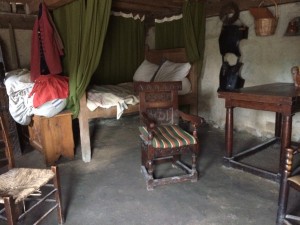
This house was the coziest.

A large family lived here.

Not all the houses had fireplaces as we know them.
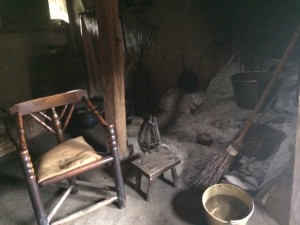
Some homes had more of a fire corner lined with stones. This was both the kitchen and the heating system.
The bread oven was the last thing on our list to locate. It turned out to be a community oven in the center of the street.
It was interesting to hear what people thought in the 17th century. Check out this clip about tallow, muscles and why Northern Europeans are tall.
Two different worlds: Wampanoag and Pilgrim women in 1620
Books for Kids on Plimoth at the time of the Pilgrims
Is it hard to imagine what life was like back in the 1600’s in Plymouth? These books might help!
Thanksgiving on Thursday (Magic Tree House series) by Mary Pope Osborne
It’s a time for giving thanks . . . when the Magic Tree House whisks Jack and Annie back to 1621 on the first Thanksgiving Day. The Pilgrims ask them to help get things ready. But whether it’s cooking or clamming, Jack and Annie don’t know how to do anything the Pilgrim way. Will they ruin the holiday forever? Or will the feast go on?
Tapenum’s Day: A Wampanoag Indian Boy In Pilgrim Times by Kate Waters
Chosen to become a special warrior prince in 1627, Tapenum prepares himself for the great honor by hunting, fishing, and sharing a day with friends and family, in a story that is complemented by photographs of Plymouth Plantation. [ages 4 and up]
Bob Villa takes us to Plimoth Plantation from a 17th-century construction point of view. The unfinished house gives a glimpse of how the Pilgrims built their homes.
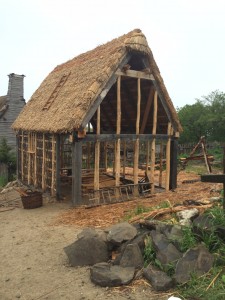
There was also a house under construction to examine.
To examine any book more closely at Amazon, please click on image of book.
As an Amazon Associate, I earn from qualifying purchases.
p.s. Related posts:
Plimoth Plantation: Learning About Native Americans
4th of July in Plymouth, Massachusetts
Contemporary Native Americans in KidLit
Notable Children’s Book Author Joseph Bruchac
Native American Picture Book of the Day
Top 10 Native American Books for Kids
Top 10 Best Native American Picture Books
Top 10 Best Native American Middle School Books
Top 10 Best Native American YA Books
Follow PragmaticMom’s board A Teachable Moment on Pinterest.
Follow PragmaticMom’s board Multicultural Books for Kids on Pinterest.
My books:

Food for the Future: Sustainable Farms Around the World
- Junior Library Guild Gold selection
- Selected as one of 100 Outstanding Picture Books of 2023 by dPICTUS and featured at the Bologna Children’s Book Fair
- Starred review from School Library Journal
Amazon / Barefoot Books / Signed or Inscribed by Me
 Amazon / Scholastic / Signed or Inscribed by Me
Amazon / Scholastic / Signed or Inscribed by Me
BEST #OWNVOICES CHILDREN’S BOOKS: My Favorite Diversity Books for Kids Ages 1-12 is a book that I created to highlight books written by authors who share the same marginalized identity as the characters in their books.

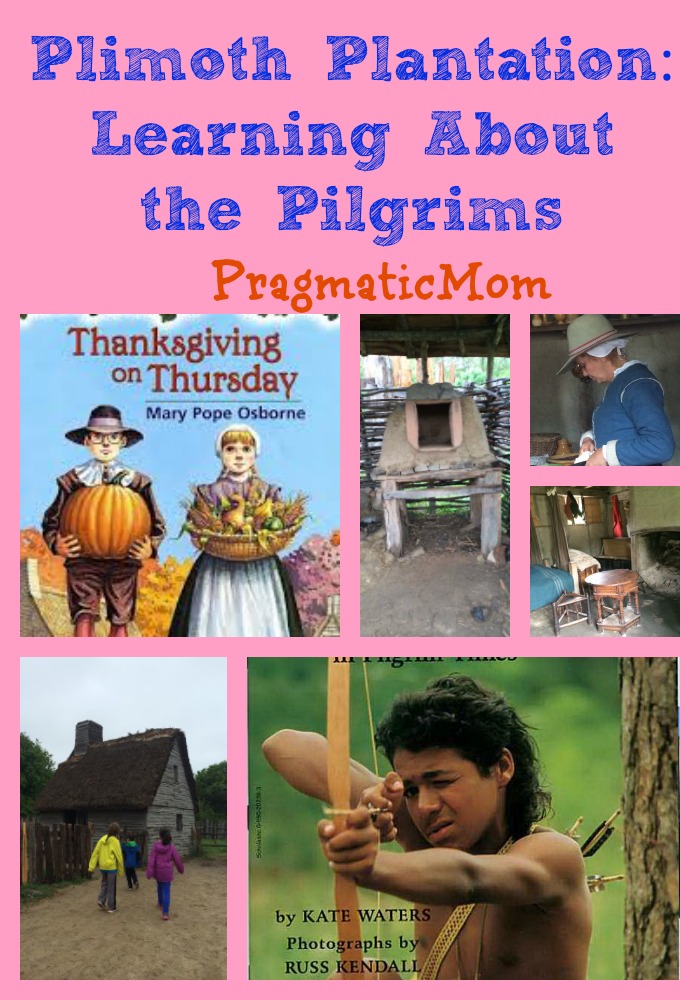













Visited this site many years ago. Thanks for sharing and reminding me that I need to get back to revisit soon.
We enjoyed visiting Plimoth Plantation when we lived in Massachusetts.
Hi MaryAnne,
My kids go there for school field trips but that was my first time! It was great and I will try to chaperone again as an excuse to see it again!
Hi Mia,
I really like how the interior of the homes are designed to reflect the different inhabitants who built them. This is a great connection for kids to see and think about, even though the technology was different in the 17th Century, and these people led very different lives in many ways, they had needs and interests no different than people today. Great post.
Hi Jim,
That’s a great point since I would have thought that homes would be more uniform but you are right; each home had a different look and feel to it! And they did vary by size according to how big the family was.
That’s cool, Mia. I love those kinds of places- they really drive the whole way of life home foe kids.
Hi Jeanette,
Come visit us in MA and we’ll take you and the kiddos there! It really is a neat place to visit! I had no idea how much fun it was to visit!
When I lived in Indiana, we’d visit places like the battle of Tippecanoe site all the time…LOVE learning about history by being placed right in the middle of it! I can never keep my eyes open just looking through a textbook. I love the pictures you took of the houses, too.
Thanks so much Galaxia,
I’ve never visited battle sites before except for Pearl Harbor (and does the Boston Tea Party ship count?!) but I think my kids would love that too! You are right; it does make history seem real!
It is fun how they stay in character! I like checking out the interiors too.
Hi Ann,
And their accents are perfect. The Pilgrims are hired actors and seem to be really enjoying their roles.